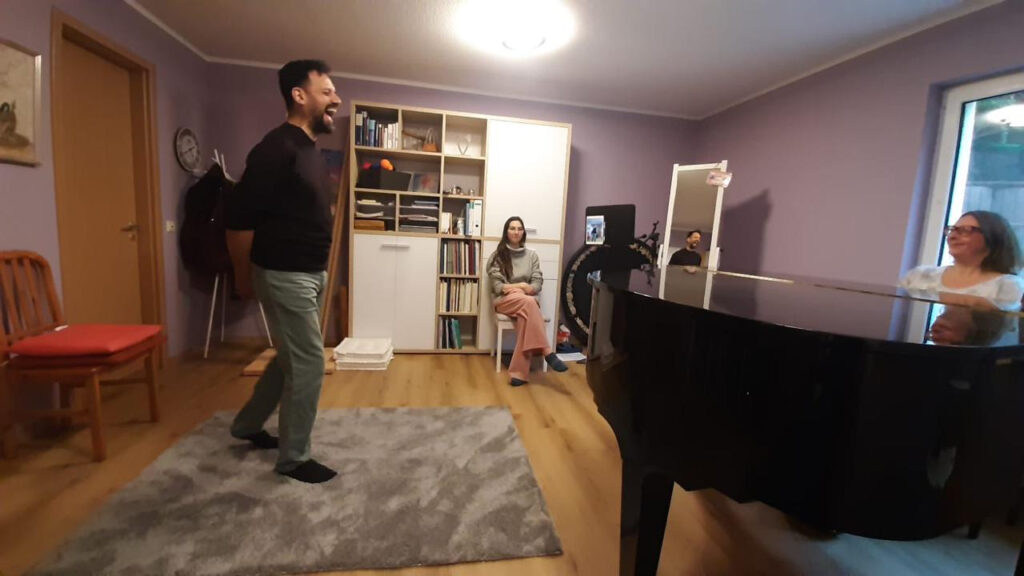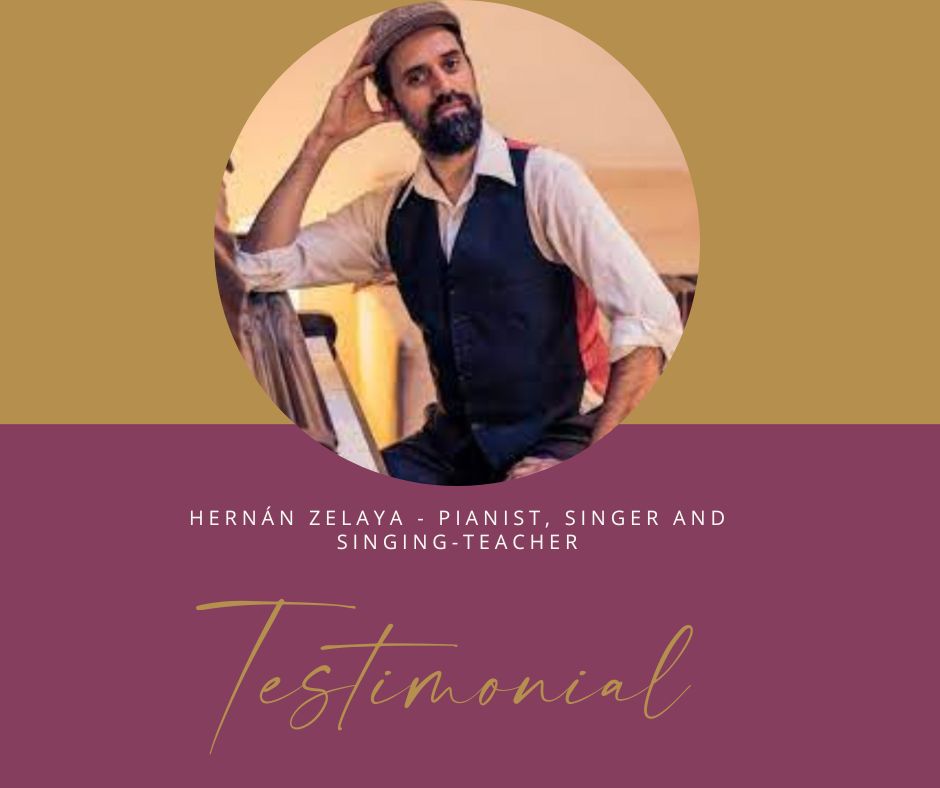Auch in diesem Jahr fand das internationale Training im Rabine-Institut für Gesangspädagog:innen und Sänger:innen statt.
Seit 2023 läuft unsere 2. Ausbildungsgruppe. Ich bin sowohl als Trainerin beschäftigt für Gruppensingen als auch theoretische Vorträge.
Und gleichzeitig finden auch Einzelstunden statt, denn da die Sänger:innen aus aller Welt kommen, ist das eine wunderbare Gelegenheit, Gesangsunterricht live zu nehmen.
Und so hatte ich das große Vergnügen, auch 2024 wieder viel Einzelarbeit mit spannenden Sänger:innen machen zu können. Einer von ihnen ist Hernán Zelaya.
Danke Hernán für dein Vertrauen und dass du etwas über unsere Zusammenarbeit geschrieben hast. 🙏
Testimonial von Hernán Zelaya
MY LESSONS WITH HILKEA KNIES IN 2024
I had two lessons with Hilkea in 2024.
In the first lesson, we talked about popular singing, and the idea of the vocal sound for that genre.
I think that whenever that expression comes out, “popular singing”, the main thought is “contemporary commercial music” and/or “musical theatre”. But when I think of popular singing, the main genres I think about are tango and Argentinian folk music. Both – but especially the latter – have very diverse vocal sounds. As a singer – but mostly as a teacher -, I have the eager to know what to do in order to sound that way.
I am convinced that Rabine Method is a powerful tool for me to know what I do with my voice – and what other singers do with theirs – to sound “tango” or “folk”. For me it’s not enough to produce -or even imitate- a certain vocal sound; I want to be able to describe what’s happening in my instrument, in objective terms. That’s perhaps the strongest reason to be committed to Rabine Method: to learn more about my voice, and at the same time about my country’s music. This is my task.

The first lesson
In that first lesson with Hilkea we worked with vowel colors. That was wonderful, because I discovered a lot of vowel colors that I can play with, and use in popular singing; like a full spectrum. The interplay between vowel color and the Gestalt of the vocal tract was very clear, and very enjoyable –and useful. Moreover, the interplay between vowel color and sound quality was revealing. These are parameters that I’m familiar with, but the depth of the work with Hilkea led me to a new level of awareness about the relationships between them.
The Great Finale of the lesson was the possibility to move “back and forth” through vowel colors (with very conscious changes in the Gestalt of the vocal tract), in order to sound more “classical” or more “natural” – the latter a meaningful word Hilkea used to describe popular singing.
The second lesson
Our second lesson was about the higher notes on mass dominant register. I’m a tenor, and tenors are those males, who are expected to sing high, and with full voice – that’s the main thing about tenors: the easy and colorful high notes. I get fascinated with some tenors, and at that time I was listening to Franco Corelli and Jussi Björling. Although in popular singing I strictly don’t need that part of my vocal range to have such a quality, I like the feeling of being able to sing that way. When I sing like that, I feel I live in a strong, powerful, big, wide, enjoyable and pleasurable body. At the same time, it takes a lot of sensibility and delicacy. That’swhere Hilkea took me to: feel the vocal folds, its shape, its elastic recoil, its reflexive movements, its tonus during inhalation and phonation.
Differentiation within the vocal folds
Indeed, to differentiate – within the vocal folds – the sensation of mass from the sensation of intensity of the tonus was the great challenge Hilkea provided me. That tonus has to be there in the vocal folds – the valve – during inhalation, in order to be able to produce an onset/Einsatz in a frequency that high in the mass dominant register; at the same time, mass has to give way in the relationship with tension. That’s an incredible delicate work. Hilkea showed me this, and then provided a set of vowels for the Einsatz, to help openness in the vocal tract. The result was astounding: a powerful – and with a full spectrum – sound in those high frequencies. That’s the tenor in me: I get a great feeling of being in that state.

Thanks, Hilkea! Waiting to have more lessons with you!
Hernán Diego Zelaya
Argentinian pianist, singer, composer, arranger and teacher, specialized in Argentinian popular music (tango and folk music). He lives in the city of Buenos Aires. He has a degree in Arts (Universidad Nacional de San Martín), and in piano teaching (Conservatorio Superior de Música Manuel de Falla). Also, he loves dancing.


1 Kommentar zu „Testimonial: Hernán Zelaya“
Pingback: KW12/2024: Alle TCS-Blogartikel - The Content Society